Koi (Cyprinus rubrofuscu) known to tropical fish keeping enthusiasts as Jinli, Nishikigoi, or Brocaded carp are brightly colored variants of the common Amur carp, which is widespread in East Asia from the Amur to the Red River drainages.
Koi (Cyprinus rubrofuscu) are native to China, Laos, and Vietnam, and were once considered a subspecies of the common European carp (Cyprinus carpio haematopterus).
Although they are different species, Koi and some Goldfish (Carassius auratus) are often misidentified by tropical fish keeping enthusiasts. Koi and Goldfish can interbreed but because they were developed from different carp species, their offspring are sterile.
Some varieties of goldfish like Comets, Shubunkins, and common Goldfish have similar body types as juveniles; but Koi have prominent barbels on their lip, which goldfish lack. Goldfish are also much smaller than koi, have a greater variety of fin and tail configurations, and body shapes. Koi can grow quite large (over 3 feet in length), while goldfish max out at about 2 feet.
History:
Carp are a highly adaptable cold water species that can survive in many climates and water conditions. Over the years domesticated carp, Koi, were propagated in many locations including China and Japan.
Carp were first selectively bred for their color in China over a thousand years ago by breeding Prussian carp (Carassius gibelio) which led to the development of various species of goldfish (Carassius auratus).
By the Song dynasty (960–1279); orange, red and white, yellow, and pure white, colors had been developed.
Amur carp (Cyprinus rubrofuscus) were aquacultured as a food fish in China during the fourth (Jin Dynasty) and fifth century with different color varieties noted.
Cyprinus rubrofuscus were first bred for their color variants in the town of Ojiya, Japan during the 1820s. Until 1914 when Niigata koi were shown at an exposition in Tokyo, Japan, nobody was aware that color variations even existed.
Since then, the interest in Koi by the tropical fish keeping community has spread throughout the world, and from that handful of Koi, all the other Nishikigoi varieties except the Ogon, were developed.
Koi are now distinguished by their colors, patterns, fins, and scales. The color varieties, basically black, white, red, yellow, blue, and cream, are virtually limitless. Breeders have categorized Koi according to combinations of color, patterns, scales, fins, and quality.
Gosanke is made up of the Kohaku,Taisho Sanshoku, and Showa Sanshoku varieties.
In the 1980s, a hybrid of Ogon Koi and wild European carp developed a “Ghost Koi” that had metallic scales. Another hybrid of Koi with Asian carp in the 1980s developed into the butterfly Koi, longfin Koi, or dragon carp.
Major Koi Varities:
- Kōhaku – isa white bodied koi with large red markings on the top. Kōhaku means “red and white”.
- Taishō Sanshoku (or Taishō Sanke) – is similar to the kohaku, except for the addition of small black markings called sumi.
- Shōwa Sanshoku (or Showa Sanke) – is a black koi with red and white markings.
- Tanchō – is any Koi with a solitary red patch on its head. The fish may be a Tanchō Shōwa, Tanchō Sanke, or even Tanchō Goshiki. It is named after the Japanese red crowned crane (Grus japonensis).
- Chagoi – is a tea colored Koi. This koi can range in color from a pale olive drab green or brown, to a copper or bronze, to more subdued shades of orange.
- Asagi – This Koi is light blue above and usually red below. It can be a pale yellow or cream, generally below the lateral line and on the cheeks.
- Utsurimono – is a black koi with white, red, or yellow markings, in a zebra color pattern. The black and yellow form is called Ki Utsuri. The red and white form is called Hi Utsuri. There is also a piebald color morph called Shiro Utsuri.
- Bekko – is a white, red, or yellow skinned Koi with black markings. The Japanese name means “tortoise shell”. The white, red, and yellow varieties are called Shiro Bekko, Aka Bekko, and Ki Bekko, respectively.
- Goshiki – is a dark koi with red (Kōhaku style) hi pattern. It is similar to an Asagi, with little or no hi below the lateral line and a Kōhaku Hi pattern over reticulated fishnet patterned scales. The base color can range from almost black to a very pale, sky blue.
- Shūsui – Means “autumn green”. It was bred in 1910 by crossing a Japanese Asagi with a German mirror carp. Except for a single line of large mirror scales that extend dorsally from head to tail, the fish has no scales. The most common type of Shūsui has a pale, sky-blue/gray color above the lateral line and red or orange (and very rarely bright yellow) below the lateral line and on the cheeks.
- Kinginrin – Often abbreviated to Ginrin, is a koi with glittering, metallic scales. Their sparkling, glittering scales contrast to the smooth, even, metallic skin and scales seen in the Ogon varieties.
- Kawarimono – is a catch all category for Koi that cannot be put into one of the other categories.
- Ōgon – is a single colored metallic Koi. Gold, platinum, and orange are the most common colors and cream colored specimens are considered rare. The variety was created by Sawata Aoki in 1946 from wild carp he caught 25 years earlier.
- Kumonryū – is a black doitsu-scaled fish with curling white markings.
- Ochiba – is a light blue gray Koi with a copper, bronze, or yellow pattern. The Japanese name means “fallen leaves”.
- Koromo – is a white bodied fish with a Kohaku-style pattern, and blue or black edged scales only over the hi pattern. The most common Koromo is the Ai Goromo, which is colored like a Kohaku, except that each of the scales within the red patches has blue or black edging.
The less common Budo-Goromo, has a darker burgundy hi overlay that gives it the appearance of bunches of grapes.
The rarely seen Tsumi-Goromois similar to Budo-Goromo, but the hi pattern is such a dark burgundy that it appears almost black. - Hikari-moyomono – Is a Koi with colored markings over a metallic base; or in two metallic colors.
- Kikokuryū – is a metallic skinned version of the Kumonryu.
- Kin-Kikokuryū – is a metallic skinned version of the Kumonryu with a Kohaku-style hi pattern. At least six different genetic sub-varieties of this general variety are known.
- Ghost Koi – is a hybrid of Ogon and wild carp with metallic scales.
- Butterfly Koi – is a long flowing finned hybrid between Koi and Asian carp. The colors depend on the koi stock used to cross.
- Doitsu-goi – were created by crossbreeding numerous different established Koi varieties with “scaleless” German carp; usually fish with a single line of scales along both sides of the dorsal fin.
There are four main types of Doitsu scale patterns:
- The most common type, Kawi Goi, has a row of scales along both sides of the dorsal fin that starts at the front and ends at the end of the dorsal.
- The second type has a row of scales that starts where the head meets the shoulder and runs along both sides of the entire length of the fish.
- The third type, Kagomi Goi, is the same as the second, but has a line of often quite large scales running along the lateral line along the side of the fish. This type is commonly called “Mirror Koi”.
- The fourth, Yoroi Goi, and rarest type is the “Armor Koi”. It is almost completely covered with large scales that resemble armor plate. It is also called Kagami-goi or mirror carp.
Koi are a hardy, peaceful, easy to maintain cold water species that are normally kept in outdoor ponds. They can tolerate swings in temperature and water quality but do not do well in areas that have extended winter temperatures. Below 50 °F their immune systems are very weak. Although they can tolerate less than perfect water quality, Koi do best with a good pond filtration system and skimmer to keep the water as pristine as possible.
Koi ponds in warmer climates should have a minimum depth of at least 3 feet. In colder climates, ponds should be at a minimum, at least 5 feet deep.
Because of their bright colors, Koi enclosures should be covered to protect them from predators, especially as juveniles. Many breeders cover their ponds with netting, wires, overhangs, etc. to prevent kingfishers, herons, raccoons, foxes, cats, etc. from feasting on their prized Koi. An uncovered pond with juvenile yellow or white skinned Koi is a dinner bell for any kingfisher or heron in the area.
Koi are easy to breed and will to spawn on their own in a large pond during the spring and summer. Females produce huge numbers of eggs that are fertilized by one or more males.
When ready to breed, the males will start following the female around the pond and bump or nudge her until she releases her eggs. After her sticky eggs are fertilized by the males, they sink to the bottom and stick to the substrate until they hatch. If the eggs can survive the first 4 to 7 days, they fry will hatch out and begin life on their own. Females can produce several spawns, but most of the fry are eaten by other fish in the pond.
Professional Koi breeders are meticulous about selecting breeding parents based on the characteristics they want to achieve, but the fry will still exhibit a wide range of colors and quality.
From the thousands of offspring produced in a single spawning, relatively few result in show quality fish. Based on the breeder’s expert eye, unacceptable Koi offspring are culled during various stages of development. The culled fry are usually either destroyed or used as feeder fish.
Older culls within the first year of growth are often sold as lower grade, pond quality Koi which is what most tropical fish keeping enthusiasts purchase from local fish shops.
Koi are omnivores that eat a wide variety of foods, including worms, crustaceans, corn, peas, lettuce, and even watermelon. Although they are bottom feeders, most nutritionally balanced commercially prepared Koi foods are designed to float on the surface so the fish can be better observed. A few food manufactures produce combinations of mixed sinking and floating pellet food.
Over time, Koi will learn to recognize the persons feeding them and will gather around them during feeding. They can even be trained to take food from you hand.
Do not feed Koi during the winter months. Their digestive systems slow down to a halt and they eat very little, if any food. Stop feeding when water temperatures drop below 50 °F.
In smaller ponds, make sure that proper oxygenation and pH stabilization occurs during temperature drops in the winter months. A good fountain pump in the center of a pond or a commercial grade bubble aerator will provide all the oxygenation needed.
When spring returns, the appetites of the Koi will also return and normal feedings can resume.
Koi can live to 50 years and longer. If you pamper and take care of your Koi, they can easily outlive you. Well cared for Koi have been reported to live over 200 years.
A famous Koi named “Hanako” owned by several people lived to be 226 years old, according to the growth rings on it’s scales.
Koi are available to tropical fish keeping enthusiasts from breeders, importers, wholesalers, collectors, online, and from almost every pet shop in the world. Prices range from just a few dollars, to literally hundreds of thousands of dollars for unique show quality specimens.
Minimum Pond Size: 300 gallons
Care Level: Easy
Temperament: Peaceful
Aquarium Hardiness: Hardy
Water Conditions: 59-77° F, KH 2-12, pH 6.8-7.2
Max. Size: 40″
Color Form: Orange, Red, White, Black, Blue, Green
Diet: Omnivore
Compatibility: Ponds or large tanks
Origin: China
Family: Cyprinidae
Lifespan: Up to 200 years
Aquarist Experience Level: Beginner

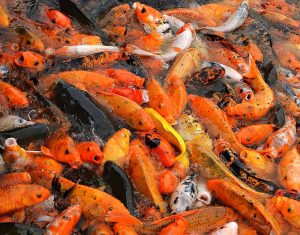
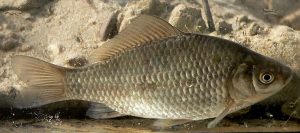
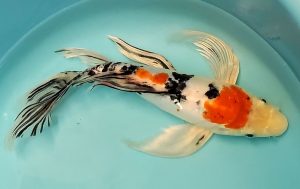
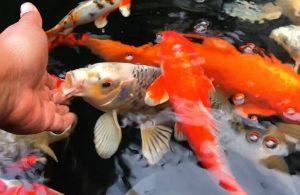
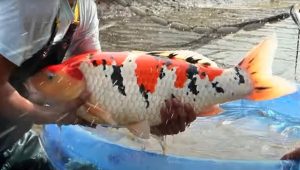

WONDERFUL ARTICLE. FOUGHT A 2 1/2 YR. LEGAL BATTLE WITH THE STATE OF MAINE INLAND FISH AND WILDLIFE TO KEEP MY PRECIOUS COLLECTION OF DOMESTIC KOI. [MAINE] IS THE ONLY STATE, ACTUALLY THE ONLY PLACE IN NORTH AMERICA THAT THEY ARE NOT LEGAL. THEY CLASSIFY THEM AS COMMON CARP.
THEY SEIZED AND KILLED ALL OF MY WONDERFUL KOI. LEMON WAS 22″ AND HE ALLOWED ME TO HOLD HIM….SPOTTY LOVED TO BE TOSSED ACROSS THE 5000 GAL. POND I MADE ABUTTING MY HOUSE…. AND RETURN TO DO IT AGAIN.
THE ONE THING I KIND OFF DISAGREE WITH IS…
Aquarist Experience Level: Beginner
THEY ARE NOT EASY TO KEEP ALIVE, AS I WAS NOT A BEGINNER IN FISH..I HAVE HAD TROPICAL FISH SINCE I WAS 8 Y.O…. I AM NOW 73. THEY ARE QUITE DELICATE AND PRONE TO STRESS THEN MOUTH ROT, SKIN ULCERS, FIN ROT…ETC ETC.
BEFORE I CROAK…. I WOULD LIKE TO SOMEHOW GET THE POWERS THAT BE CHANGE THEIR CLASSIFICATION AND PUT THE KOI ON THE “UNRESTRICTED LIST”…. WE ARE ALLOWED GOLDFISH… WHICH I FEEL ARE A HARDIER FISH. THEY KEEP SAYING ‘WHAT IF THEY ARE RELEASED IN OUR NATIVE WATERS?’…. WELL AREN’T OTHER STATES WORRIED? ONE JUDGE ASKED THAT OF THE D.A. THE SYSTEM THEY USE IS VERY FLAWED.
You gotta love the government.
I concur with your comment on experience level, however, in general the consensus is that keeping Koi is OK for beginners. You would definitely have an argument from most of the Japanese and Chinese breeders who maintain pristine water quality for their prized fish.
Thanks for the info on Maine’s screwed up legislation.